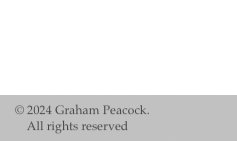|
Painter takes industrial approach to art
Reclusive attitudes, fine palette work, ascetic detachment not exactly Peacock's cup of tea
ELIZABETH BEAUCHAMP, The Edmonton Journal. March 21, 1992
LArtists' studios, like paintings, have altered considerably since the days when the easel, brush and beret were de rigueur.
If someone, say Renoir for instance, could time slip to Graham Peacock's modern studio, the old gent would be in for the surprise of his after-life. Sure, he'd see that generous windows are as important as ever. And judging by the creaky old conveyance that lifts visitors up to the light-filled studio in the heart of downtown, elevators haven't changed much.
But just about everything else has.
A new-age painter dressed in mechanic's overalls, whipping up giant pails of fluorescent colors with an industrial mixer comes as a surprise even to those of us who were actually born in this century.
And then there are the long, low wooden troughs laid with canvas, onto which Peacock pours paint thick as honey and bright as modern technology allows.
These rivers and pools of pure color dry, shrink and crack into abstract shapes to the hum of big floor fans. They're further upset by trickles of yet more vivid shades. No paint brushes, palette knives or even a palette are anywhere in evidence.
At some point, the paintings became the palette. The place where the colors are invented, mixed and separated. So the process of the making is clearly visible on the finished surface.
Instead of gentle transitions between pigments, there are harsh jostlings and acidic shades which seem burnt into the canvas. Aggressively, joyous pairings of opposites are flaunted for optimum punch.
While most historical painters would be floored by all of this if they could see it, there is one who would probably understand. For here is a natural extension of Jackson Pollock's great drip paintings of the 1950s.
However, Peacock's process is also as much about editing as about painting. Choosing, cutting, contouring and shaping the choice works from a roomful of experiments. The inventor seems at times the passive recipient of the magic he has set in motion.
The author of all this visual mayhem, Graham Peacock, was born in London, England and came to Edmonton to teach painting at the University of Alberta in 1969. For most of that time he has been one of the most radical of those working in the modern style for which our art community is known.
Alternately shocking and attracting, these are works you either love or hate. Random possibilities are pushed to their limits. Images of lava flows, imaginary planets, even photo's of Earth taken from space come to mind.
Although this adventure into unknown territory is rooted firmly in modernist abstraction, it all has a pop art, pop culture feel. It's modernism for the post-Warhol, music video generation.
But there's not much of it around. Long after the rest of the contemporary art world abandoned the issues surrounding the rage that came out of mid-century New York, a group of local painters embraced it.
And while there's a rather stiffing, retro-overtone to the whole scene (often as confusing as an experience in dejavu that you just can't place) there's also the occasional burst of excitement.
Walking into Colour and Dimension, Peacock's show on till March 29 at the FAB Gallery the University of Alberta campus is an experience in the latter.
Although most of his modernist colleagues have retreated into a form giant ameboid puddles low-key, almost monkish examination of the slightest subtlety of tone and texture, Peacock insists on taking highly-public, artistic risks.
With colors that look like they've bubbled up and overflowed down the sides of a chemical caldron to against the unsuspecting walls, this is a show that's nowhere close to retirement.
At a time when many artists remind anyone who will listen that fine art just isn't rock and roll, but something more serene and contemplative, along comes visual art's equivalent to a full-decibel night at the Coliseum.
Forget the ear-plugs. Just bring your shades.
|
|
|



